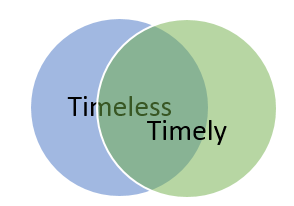Timeless and Timely Learning
September 4, 2018 - 5 minutes readWith the exception of mass extinctions, many would argue that the world is changing more quickly now than ever before; climate, as well as technology changing the way people live, are two of the most obvious examples.
In the late summer, West Vancouver Schools principals and vice-principals participated in a workshop with Discovery Education’s Hall Davidson. Mr. Davidson spoke about some of the technologies that are, and will, change the way students learn including Artificial Intelligence (AI), Virtual Reality (VR), and Augmented Reality (AR).
Disruptions to the status quo that prompt change are often a good thing, but they can also distract from an organization’s or a system’s true purpose. The disruption could also be significant enough to alter an organization’s or system’s purpose.
In an elementary school, when evaluating the benefits of new tools and ideas in education, and trying to gauge how much prominence, if any, such tools and ideas should have in the learning of 5-13 year olds, a lens or framework is helpful. Over the summer, I’ve been thinking about learning that is timeless, timely or both.
In an elementary school, there is still plenty of room for teaching timeless skills: reading, writing, numeracy and social and emotional learning. The value of these skills has never diminished and many would argue that with the internet providing access to abundant and potentially overwhelming information, as well as providing platforms (blogs, social media such as YouTube, Instagram, Facebook, and Twitter) for self-expression and an audience, literacy skills are becoming even more valuable.
There is also great value in teaching timely skills and concepts. The increasing role of technology in our lives makes learning the basics of computer programming timely; coding is interesting to many students and is becoming another part of understanding the world.
As one evaluates the prominence that coding or any other timely learning such as VR and AR should play in a young person’s education, it is worth examining if that timely learning has timeless roots. For coding, there is much to be learned about the concepts of computational thinking such as (1) breaking a problem down into parts or steps, (2) identifying patterns, (3) developing instructions to solve a problem, and (4) generalizing patterns into rules. Such concepts of problem solving are applicable for areas of learning unrelated to technology and possibly fall into the timeless category. If in the future machines come to do almost all of the coding and coding becomes a far less valuable skill, or less valuable for many people to have, the skills and concepts of computational thinking will endure and continue to be taught.
Even without timeless roots, however, there is room for timely learning. In addition to it (usually) being interesting, timely learning also helps students understand what it means to be a learner. Thriving in a period of rapid change requires curiousity and open-mindedness to try new things, agility to adapt to change, and pivoting to work around roadblocks. Sometimes what is learned (content, skill, or competency) is less important than developing key traits of a learner’s mindset such as open-mindedness.
The overlap between “Timeless” and “Timely” learning continues to expand. Timeless learning such as developing literacy skills should, whenever possible, incorporate timely enhancements such as using tools like Google Read & Write to help with comprehension, or Discovery Education Techbook to access vetted, developmentally appropriate, resources.
I don’t have the answer for how much learning should be timeless, timely, or both, only that learning should be in all three zones.
In 1920, the artist George Bellows said,
Try everything that can be done. Be deliberate. Be spontaneous. Be thoughtful. Be painstaking. Be abandoned and impulsive. Learn your own possibilities.
Learners – whether they be educators or students – can be many things, whether it be a teacher very carefully crafting a well-developed year plan of how a student is going to learn to read or at other times, they can be spontaneous, maybe even “abandoned”, in trying something new simply because learners should try new things. Such is the mindset of someone, or the culture of an organization, with great possibilities.

0 Comments